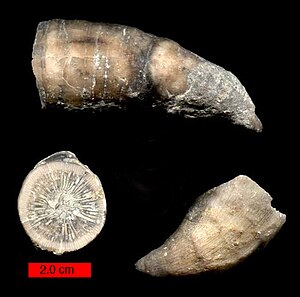Rugosa
| Rugosa | ||||||||||||
|---|---|---|---|---|---|---|---|---|---|---|---|---|

A specimen of the solitary genus Grewingkia from the Ordovician of Indiana (USA) in three views . Scale 2.0 cm |
||||||||||||
| Temporal occurrence | ||||||||||||
| Ordovician to Upper Permian | ||||||||||||
| 485.4 to 251.9 million years | ||||||||||||
| Locations | ||||||||||||
| Systematics | ||||||||||||
|
||||||||||||
| Scientific name | ||||||||||||
| Rugosa | ||||||||||||
| Milne-Edwards & Haime , 1850 | ||||||||||||
The Rugosa ( Syn. : Tetracorallia) are an extinct order of Hexacorallia that from the middle Ordovician to late Permian to the reef formation were involved. The German name "Wrinkle Coral " ("rugosen corals ") corresponds to the Latin name and refers to the wrinkled outer shell ( Latin rugosus - wrinkled, wrinkled). The name "Tetracorallia" ( tetra ( τετρα ) - four) the animals owe their four-rayed, axially symmetrical construction plan .
Together with the tabular corals (Tabulata), the Rugosa were the first reef formers among the flower animals . Together with the tabulata and stromatopores , they formed the largest reefs in the Paleozoic in the Silurian and Devonian , the so-called tabulata stromatopore reefs.
About 75 percent of all Rugosa were solitary species, the rest formed colonies .
Solitary rugosa are also known as horn corals (not to be confused with gorgonians, also known as horn corals ) because of their characteristic skeleton . The largest reached a diameter of 14 centimeters and a length of almost a meter. Colonies could reach four meters in diameter.
It cannot be proven whether rugose corals, like many corals of today, lived together with symbiotic algae ( zooxanthellae ).
In the Upper Devonian, the Rugosa and Tabulata became mass extinctions in the course of repeated sharp rises in sea level , with 90 percent of the shallow water and 50 percent of the deep water forms disappearing. They didn't recover from it. With the great mass extinction on the Permian / Triassic border, they finally died out, like many other creatures , with the exception of a few genera of the suborder Streptelasmatina.
The increased number of growth rings in the rugosa skeleton compared to recent corals, i.e. those living today, is an indication of the assumption that the speed of the earth's rotation was higher in the geological past than it is today. In Devon, a day lasted about 22 hours and a year therefore had 396 days.
Systematics

The rugosa are divided into three sub-orders according to the fine structure of their skeletons:
- Columnariina (Ordovician - Perm)
- Cystiphyllina (Ordovicium - Devonian)
- Streptelasmatina (Ordovician - Lower Triassic)
Web links
- Rugosa page at Palaeos.com (English)